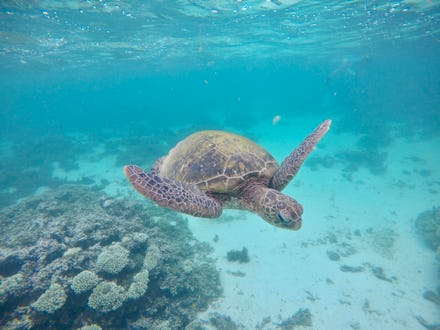Australia’s Ningaloo Reef is overshadowed by the Great Barrier Reef — but it’s just as awe-inspiring

It’s unfair, really, that the Great Barrier Reef in Queensland, Australia, has the word “great” in its name; most travelers don’t even realize the Land Down Under has another world-class ranch of coral and large-scale marine animals. The Ningaloo, which roughly translates to “promontory” in a local aboriginal dialect, is a sprawling fringe reef along Western Australia’s undeveloped coast protected by not one but two UNESCO World Heritage mandates. Expect manta rays, thousands of sea turtles and dozens of sharks like whale sharks, hammerheads and alien-like wobbegongs. There’s also a so-called “humpback highway,” with some 35,000 whales that migrate through each season.
Unlike the Great Barrier Reef, the diving and snorkeling sites of the Ningaloo are right along the coast — sometimes they’re so close you can walk into the water with your tank on and explore. In fact, the Navy Pier, near the town of Exmouth, is considered one of the best shore dives in the world. Dive Ningaloo takes groups of about 17 in the water at a time to explore the massive schools of fish and sharks. But Navy Pier is also on a contractual lease set to expire November 2019 — which means there may only be 11 more months of guaranteed exploration.
A hidden-gem attraction
You don’t have to travel to Australia’s Red Centre to have the ultimate outback experience — the cattle ranch at Bullara Station offers some honest-to-goodness bush accommodation. Pitch a tent in the sand and listen to the sounds of shy kangaroos as they scamper by, or take up residence in one of the ranchers’ cottages sided with aluminum and clapboard shutters.
Animal-friendly initiatives
The town of Exmouth is the best base from which to interact with the legions of whale sharks that visit the reef each year. Its handful of operators offer day-long tours to find the world’s biggest fish, but education plays a major factor in the day’s activities. Face time with the creatures (a spotter in an airplane helps increase your chances of seeing at least one) is pared back to short encounters. When you’re on deck, it’s all about learning details of the creature’s biology and promoting awareness of their endangered status.
Insider intel
Socially sustainable tourism is just as important as keeping the environment in mind. Support aboriginal-run experiences that illuminate the rich cultures that thrived for tens of thousands of years before Europeans settled on the continent. Spend a day out in the desolate dunes of Francois Peron National Park with Darren “Capes” Capewell, the founder of Wula Gura Nyinda Eco Cultural Adventures, exploring the land and learning about its ancient local customs.
For more of Mic’s Best Places to Travel in 2019, explore our map or view the complete list here.